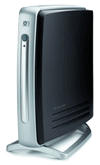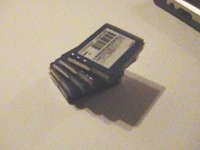What is New |
|
| 3G & 4G | |
3G (or 3-G ) is short for third-generation technology . It is used in the context of mobile phone standards. The services associated with 3G provide the ability to transfer simultaneously both voice data (a telephone call) and non-voice data (such as downloading information , exchanging email , and instant messaging ). For more details : http://en.wikipedia.org/wiki/3G |
|
| 4G (or 4-G ) is short for fourth-generation , the successor wireless access technology to 3G . It is not used consistently, but generally describes several different, but overlapping ideas. 4G technology stands to be the future standard of wireless devices. The Japanese company NTT DoCoMo and Samsung are testing 4G communication at 100 Mbit /s while moving, and 1 Gbit /s while stationary. For more details : http://en.wikipedia.org/wiki/4G |
|
| RFID | |
| Radio Frequency Identification ( RFID ) is an automatic identification method, relying on storing and remotely retrieving data using devices called RFID tags or transponders . An RFID tag is an object that can be attached to or incorporated into a product, animal, or person for the purpose of identification using radio waves. Chip-based RFID tags contain silicon chips and antennas . Passive tags require no internal power source, whereas active tags require a power source. For more details : http://en.wikipedia.org/wiki/Radio_Frequency_Identification |
|
| Mobile Virtual Network Operator (MVNO) | |
MVNO services in India It involves a marketing and branding outfit which buys airtime from an existing mobile service provider that owns equipment and licence rights for these services. For details click here |
|
| Thin Client / Net Computer | |
| A thin client is a computer (client) in client-server architecture with as little hardware and software as possible. The thin client devices do not include hard disk drives, & will use read-only storage such as a CD-ROM , Network Virtual Drive. A thin client does most of its processing on a central server located nearby in a LAN or at a distance on a WAN or MAN. For More Information : http://en.wikipedia.org/wiki/Thin_client http://www.vecmar.com/thin_client/thin-client-explained.htm |
 |
| Near Field Communication | |
|
Near Field Communication Technology holds the promise of bringing true mobility to consumer electronics in an intuitive and psychologically comfortable way since the devices can hand-shake only when brought literally into touching distance
http://en.wikipedia.org/wiki/Near_Field_Communication http://www.ecma-international.org/activities/Communications/2002tg19-010.pdf http://searchmobilecomputing.techtarget.com/sDefinition/0,,sid40_gci967849,00.html |
|
| Blue Tooth | |
| Bluetooth technology that enables short-range wireless connections between desktop and notebook computers, handhelds, personal digital assistants, mobile phones, camera phones, printers, digital cameras, headsets, keyboards and even a computer mouse. Bluetooth wireless technology uses a globally available frequency band (2.4GHz) for worldwide compatibility within the 10 metres range. For More Information : http://en.wikipedia.org/wiki/Bluetooth http://www.apple.com/bluetooth/ |
 Bluetooth USB Adapter |
| Wi-max | |
| WiMAX is a wireless digital communications system, also known as IEEE 802.16, that is intended for wireless "metropolitan area networks". WiMAX can provide broadband wireless access up to 30 miles (50 km) for fixed stations, and 3 - 10 miles (5 - 15 km) for mobile stations. For More Information : http://www.wimax.com/education http://www.ti.com/asia/docs/india/tiidevconf2004/technology/shyamshetty.pdf |
|
| Wi-Fi (wireless fidelity) | |
| WiFi/802.11 wireless local area network standard is limited in most cases to 100 - 300 feet (30 - 100 metres). A user with a "Wi-Fi" product can use any brand of access point with any other brand of client hardware that is also Wi-Fi. Any Wi-Fi product using the same radio frequency (for example, 2.4GHz for 802.11b or 11g, 5GHz for 802.11a) will work with any other, even if not "Wi-Fi". For More Information : http://www.webopedia.com/TERM/W/Wi_Fi.html http://en.wikipedia.org/wiki/WiFi |
|
| GPRS | |
Usually, GPRS data are billed per kilobytes of information transceived while circuit-switched data connections are billed per second. The latter is to reflect the fact that even during times when no data are being transferred, the bandwidth is unavailable to other potential users. |
|
| GSM | |
| The Global System for Mobile Communications ( GSM ) is the most popular standard for mobile phones in the world. The GSM standard makes international roaming very common between mobile phone operators , enabling subscribers to use their phones in many parts of the world. GSM was first introduced in 1991. As of the end of 1997, GSM service was available in more than 100 countries. In GSM both signaling and speech channels are digital , GSM uses narrowband TDMA , which allows eight simultaneous calls on the same radio frequency. The key advantage of GSM systems has been higher digital voice quality and low cost to making calls such as text messaging. For More Information : http://en.wikipedia.org/wiki/GSM http://www.webopedia.com/TERM/G/GSM.html |
 GSM Base Station |
| CDMA | |
| Code Division Multiple Access (CDMA) is a "spread spectrum" technology, allowing many users to occupy the same time and frequency allocations in a given band/space. As its name implies, CDMA (Code Division Multiple Access) assigns unique codes to each communication to differentiate it from others in the same spectrum. In a world of finite spectrum resources, CDMA enables many more people to share the airwaves at the same time than do alternative technologies. CDMA communication consists of a Radio Carrier Station (RCS) and a Subscriber Unit. For More Information : http://www.webopedia.com/TERM/C/CDMA.html http://en.wikipedia.org/wiki/CDMA |
|
| TFT Screen | |
Short for Thin Film Transistor , a type of LCD flat-panel display screen , in which each pixel is controlled by from one to four transistors . The TFT technology provides the best resolution of all the flat-panel techniques, but it is also the most expensive. TFT screens are sometimes called active-matrix LCDs. For more information
|
|
| Lithium Ion Battery | |
| Lithium ion batteries (sometimes abbreviated Li-Ion ) are a type of rechargeable battery commonly used in consumer electronics. They are currently one of the most popular types of battery, with one of the best energy-to-weight ratios, no memory effect and a slow loss of charge when not in use. They can be dangerous if mistreated, however, and unless care is taken they may have a shorter lifespan compared to other battery types. A more advanced lithium-ion battery design is the lithium polymer cell . For more information: |
 |
| Fuel cell | |
A fuel cell is an electrochemical energy conversion device similar to a battery, differing in that it is designed for continuous replenishment of the reactants consumed; i.e. it produces electricity from an external supply of fuel and oxygen as opposed to the limited internal energy storage capacity of a battery. Additionally, the electrodes within a battery react and change as a battery is charged, or discharged, whereas a fuel cell's electrodes are catalytic and relatively stable. Typical reactants used in a fuel cell are hydrogen on the anode side and oxygen on the cathode side (a hydrogen cell). Usually, reactants flow in and reaction products flow out. Virtually continuous long-term operation is feasible as long as these flows are maintained.
|
 |